In Pamekasan, towards the heart of Madura, the elements take their cues from none save themselves. And nowhere more than in the village of Larangan Tokol, the home of Api Abadi the eternal fire, does this truth become clear.
For the most part, the elements act as hoped in Indonesia – the water quenches, the fire burns, the air hovers, the earth waits. They may take exaggerated forms, with natures grotesque and unfeeling, but their roles stay broadly the same.
Sometimes, though, it seems an impish jester has assumed control of the elements’ ways. And so doing, the rascal subverts their power. Few know whether such chaos has taken root on Madura.
This includes the curious, kicking their heels in this north-east corner of Java and ready to trace a path to Api Abadi from Pamekasan’s alun alun. There, they may see the Monumen Arek Lancor, shaped like the traditional Madurese sickle.
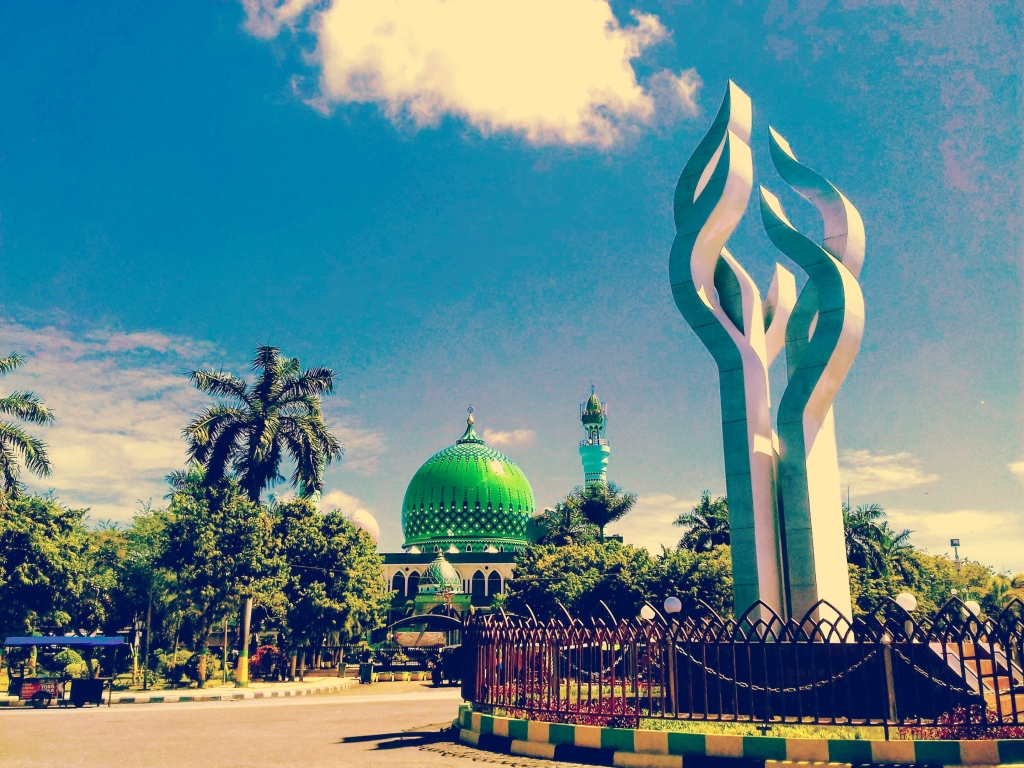
The monument writhes out of the ground as though locked in prayer. Behind it stands the ornate Masjid Agung Asy-Syuhada; to the front, the Bunda Maria Ibu Para Rasul Catholic Church. Many agree that glimpsing a cloudless blue sky pierced by the rich green of the mosque’s curved roof ranks among Madura’s most enduring sights.
A closer check of Arek Lancor reveals the symbol’s likeness to the word “Allah”. Here do the curious gain some sense of how life works on Madura, and that faith holds great sway.
READ MORE: Peering Through: Tana Toraja and Life Under the Surface
But not all the curious have faith. And innate belief has no bearing on this story, save perhaps for the inkling that not all things work as they should. Thus, a receptive ear may catch a whisper floating on the wind, directing those who should hear it to the city’s southern outskirts. There they may find Api Abadi, where the flame burns without relent.
Wingless flight
The centre and the outskirts are rarely the same thing, however. Reaching one can mean a long traipse from the other, no matter the path the walker, burdened by a lack of wings, may take. The whisper intimates heading south along Jl. Truncjoyo to find Api Abadi, and it is this direction the curious should take.

It does not take long for the curious to become a source of curiosity themselves; for many stalls line this road, and their holders, perceptive like many Madurese, soon sense the presence of an outsider.
Since there is no risk of Api Abadi going out, the walker should take care to talk with those who may greet them on the way. One school of thought suggests that all people have a guardian angel, and that this angel may stalk the most unlikely of places; perhaps they wait on Truncjoyo Road to meet their curious charge. Other people may share news of the karapan sapi bull races, that the Madurese call Kerrabhân sapè; some, piqued by a rare newcomer in this part of Java, may wish only to pass the time of day with a stranger.
And so the curious walker creeps towards Api Abadi, the townsfolk’s propensity to welcome strangers – ‘a guest is a gift from God’ a recurrent greeting – adding many hours to their journey. But the road is straight and the 6km-journey manageable, and the curious feels no pressure to complete their task.

Instead, they choose to take a diversion to a place of sport. Bearing left, the visitor heads along Jl. Ray Ceguk, the road they must follow if they wish to find Stadion Gelora Madura Ratu Pamelingan in amongst the surrounding fields and villages. The road to the stadium is a peaceful place, where even the drone of car and bike becomes swallowed up by the landscape. And the space is open without unnerving loss of depth and perspective and busy enough that one may feel no pang of loneliness.
Open ground
As for the stadium itself, little needs saying. The open bowl, lying flat with supine ease, inhabits the same level of flat openness as the land about it. And it exudes a blissful calm. In a bygone age, wise heads chose to finish this place in shades of orange so that the paint blends with the setting sun. So doing, the colours suggest a space of infinite size in which stalk all manner of grand things. A receptive soul may thus feel a vague longing in the pit of their stomach that some may liken to melancholy but tinged with the warmth born of communion with something far greater than themselves.
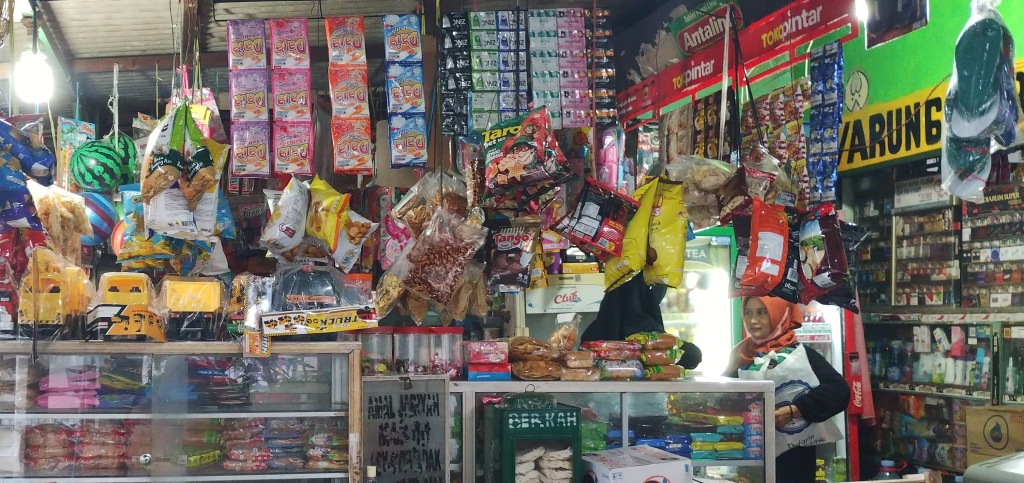
Turning back from whence they came, the walker will find terminal Ronggosukowati. There, one may find rides across Madura. Others in need of food may find nasi bebek; kopi is never far behind. And the attendant kretek, which enhances both things, always fills the air with its scent of cloves and warm crackle.
READ MORE: Grisly Passage: Tana Toraja and the Cost of Dying
On occasion, a figure emerges from the dying light near this terminal. A human-like shadow first forms, moving with pronounced feminine grace. The person – for it becomes clear that, as the features harden, this outline belongs to a person – gradually comes into focus. The viewer is dazzled by the loud and colourful clothing that sits naturally upon the advancing frame. The cut is low, the sequins dazzle, and the skirt ends high above the knee. One may see reams of open flesh upon this canvas. Where others on Madura prefer modesty, this character revels in their glitz. But the person’s stubble and gruff, masculine voice, remoulded to become sultry, offset their outré feminine attire. Their eyes burn as they cast appraising glances over the curious, who can only assume that this passer-by, even now stalking into the night, lives just as they wish. The curious, while respectful of the prevailing cultural mores that set out definite parameters for how a native of Madura should act, feel nought but respect for this person’s honesty and wonder how the battle would play out between strict censure and one who would escape their prescribed role in life.
Route change
Such tangents often occur in Pamekasan. And those who seek Api Abadi fear not, for they know that the fire shall not go out, which creates time to see other places. But the blaze also exerts a magnetic pull that eventually returns all pilgrims to their previous course. After some time – the sun has fallen, vanquished by the moon – and long past the stalls selling bakso hitam, where the meatballs seem descended from blocks of charcoal, and past the university, along a road that now calls itself Jl. Raya Larangan Tokol, an innocuous sight hoves into view: the red, yellow, blue and white frontage of the most common toko in all of Indonesia. A sign that directs, indirectly, those on the path to Api Abadi to turn right down an unnamed road. They should then climb a small peak before descending to the village of Larangan Tokol where, at last, they may find the flames they seek.
The eternal fire sits within a 10-metre space. A hexagonal fence rings it. Around the area, one may find the kind of bustle bred in a place that attracts crowds: a small market has sprung up around Api Abadi, and food and drink vendors pass by with their carts. A couple of guards rest on their haunches, on the lookout for people who may burn themselves. The aroma of chicken and corn, grilled on the fire, insinuates itself. Villagers mill about and pass the time of day, which lends the scene an informal air. And all eyes focus on the pockets of flame.
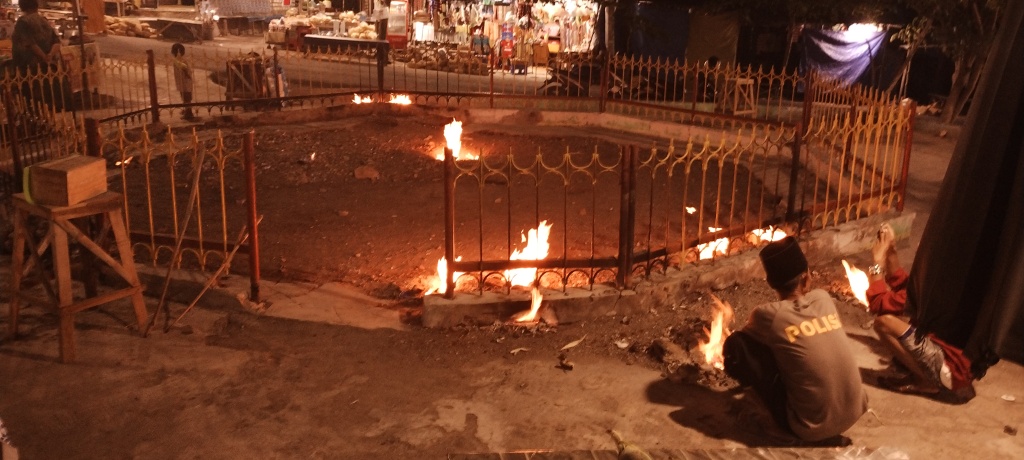
Mostly, the fire rests within the fence. A few pockets may spill into the ground around it, but never with chaos. For Api Abadi is a controlled element. It gives no impression of heralding the arrival of a far more feral beast of flame. Instead, the curious may note an overriding mood of reflection. Api Abadi draws out mostly murmurs from its visitors, some of whom feel compelled to step away from the heat.
Oil reek
A vague sense of mystery permeates the site, uncovered in 1945 during the reign of President Soeharto. Studies of the land’s gas and oil content revealed nothing conclusive, save that the bowels of the earth churn out endless bursts of petroleum. Those who drill wells in the area find that the water reeks of oil. The presence of sulphur in the soil looms large which, when reacting with oxygen, results in flames. And Api Abadi intensifies such logic: the fire burns like a gas stove and reignites itself, unbidden, when rainfall snuffs it out.

Few places like this exist in Indonesia. Visitors will see two sites of fire: apoy lakè, or male flame, in the heart of the village, and apoy bini’. This female flame one may find in the nearby rice fields. The outsider may never know the meaning of this male-female duality. Only that those who senggali sedikit, or dig a little, will uncover a fire that forever burns.
Whispers surround Api Abadi as to its history. The tendrils of lore stretch back to the 17th century, to 1683. There, they land upon a Madurese word-bearer of Islam named Raden Wiknu Kenongo. His knowledge earned him the nickname Kiai Moko. A reader familiar with Madura may know that the kiai fulfils the role of a religious leader, whose counterparts include the kleben (village heads) and the blater (local strongmen).
READ MORE: Walking With Purpose: A Pilgrimage to Asta Tinggi Royal Tombs
Thus, Kiai Moko, once a fisherman, became known for his religious bent. But so too, sources suggest, his power moved in other, more obscure ways.
Regal stone
One story has it that Moko heard tell of tragedy in Sumatra: the King of Palembang’s daughter had fallen ill, and fears grew for her survival. The kiai took it upon himself to send a gift of bamboo to the royal court. Within this gift lay a set of fish eyes which, when touched by the king, turned into a jewel. Such was the wonder of this bounteous surprise that the ill patient’s malady quickly faded. The grateful king welcomed Moko into his inner circle and pledged to the kiai his daughter’s hand in marriage.
One package begat another, and this time in the opposite direction. The king sent the kiai a chest of his own, which held a gift of even greater worth than the one that triggered the exchange. For inside this chest awaited Siti Suminten, the king’s daughter and Kiai Moko’s betrothed.

But Moko, for all his power, remained at heart the humble fishermen of his former days. And his fears grew that, as the wedding approached, he could not offer the princess the ease of life he thought she deserved. The learned one sought divine help.
For one thing, Kiai Moko feared that the royal entourage would find his home in Pamekasan, in the village of Larangan Tokol, too dingy and not befitting their royal status. He sought grandeur and light and, charged by his calls to the Almighty, struck his staff into the ground. A great rendering did then occur, and tumult arose where none had been before. And in chaos’ wake, there did appear a grand palace, great lakes and a fire of vivid intensity.

Relief abounded for Kiai Moko. The wedding, within the grounds of the miraculous palace, proceeded splendidly, and all agreed that this new union was a thing of rare beauty. And come the celebration’s end, the grateful Moko watched as the palace faded and the lake vanished. He awaited the fire’s similar retreat. But the fire did not budge. Instead, it stayed radiant and very much in place.
The fire had helped the kiai enormously; Moko did not want the fire to expend its energies needlessly and gave it leave to return to its source. But the fire evidently came from noble stock and pledged to stay where it was, to accompany and warm Moko’s children and all his descendants and followers until the end of time.
Thus did Api Abadi, the undying fire, come into being. And to this day, it still burns as an endless reminder of love, life and the wonder of light.

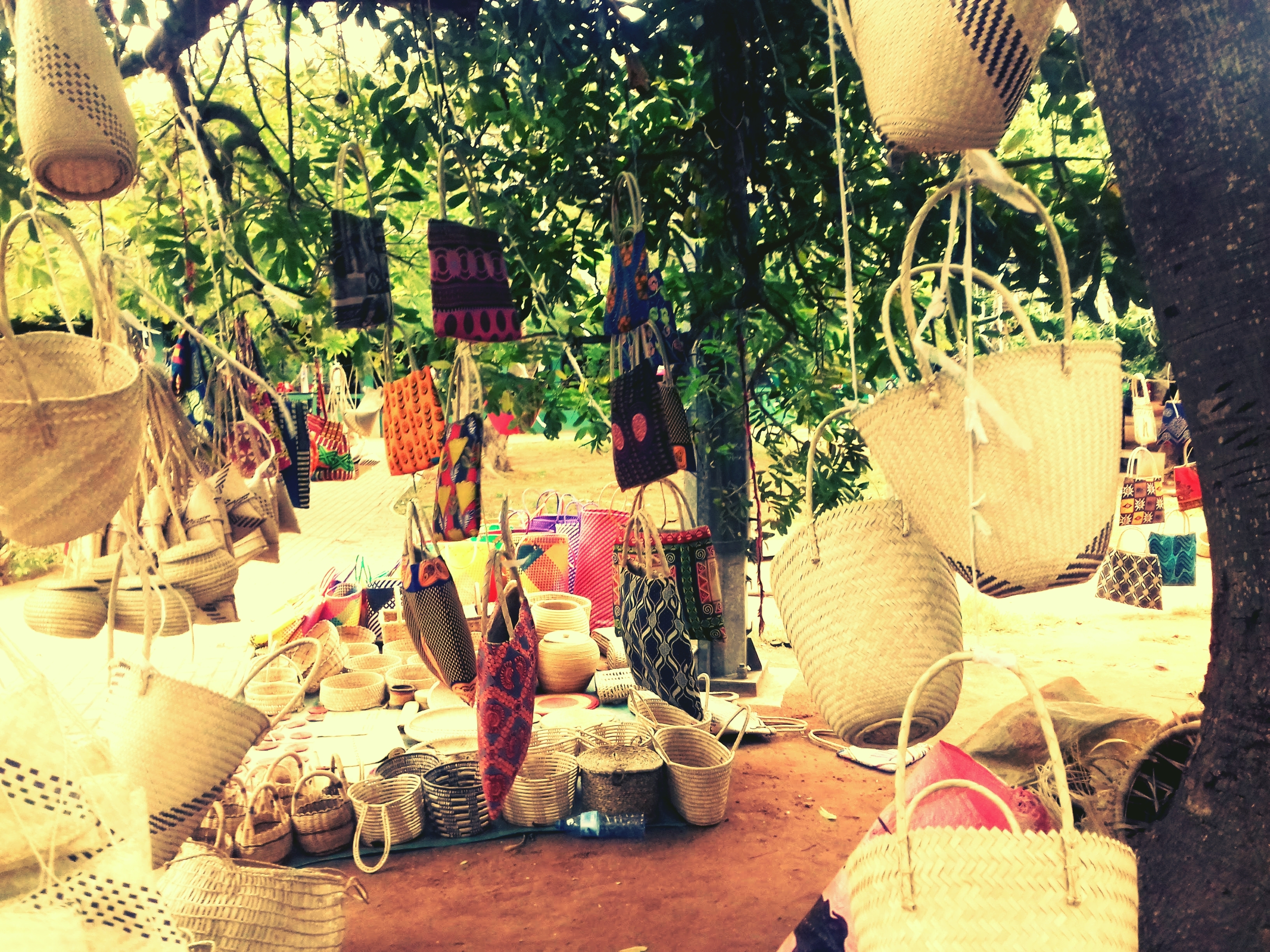

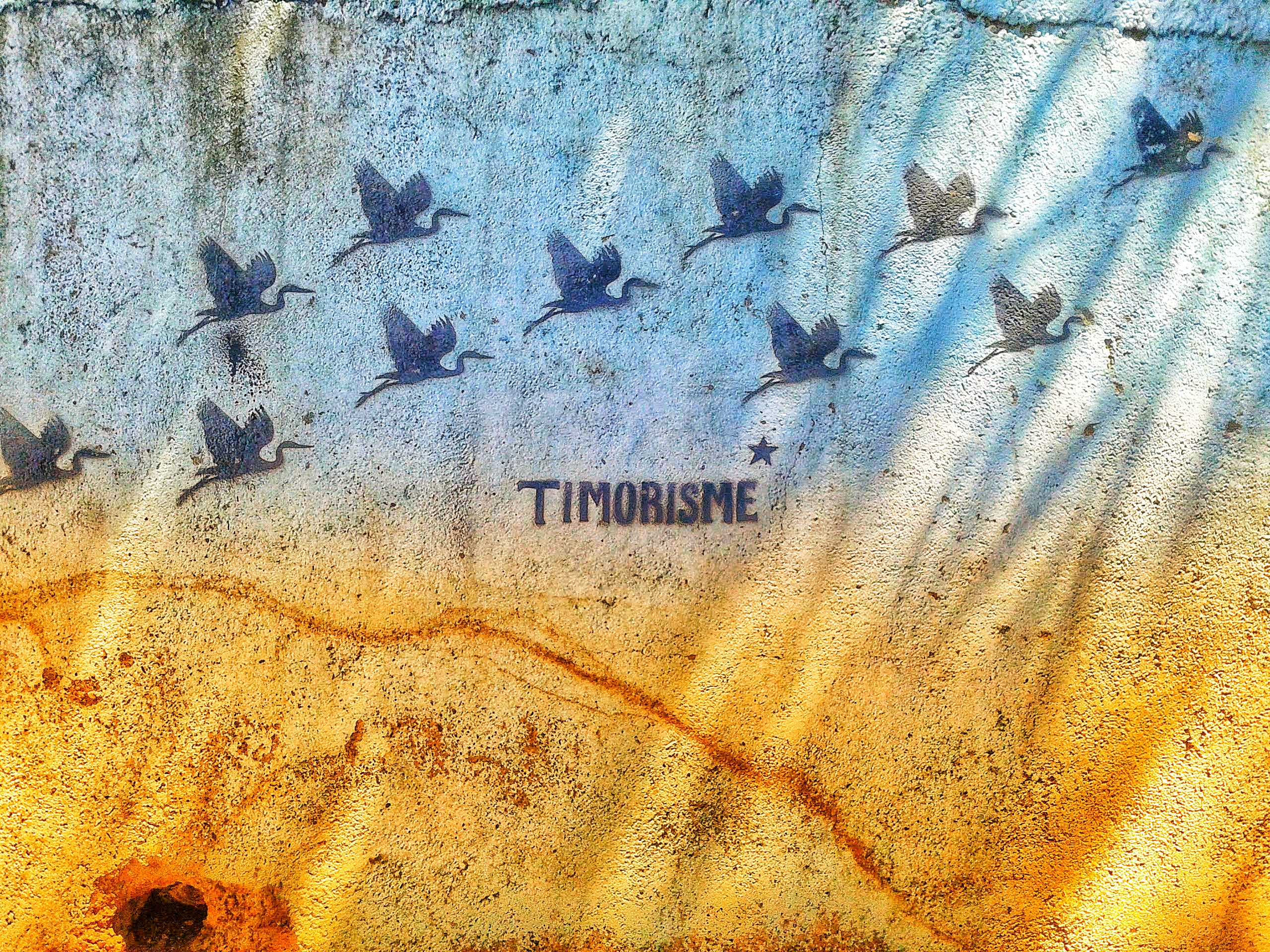

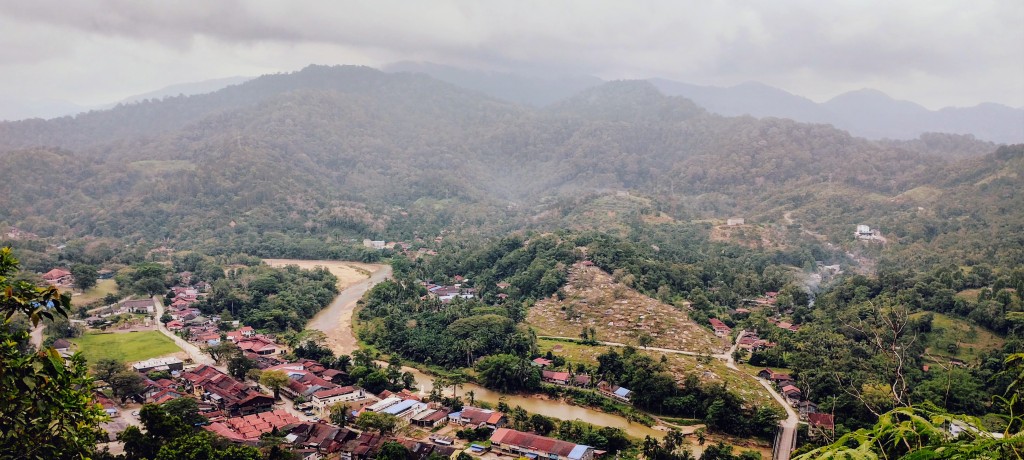

Leave a comment